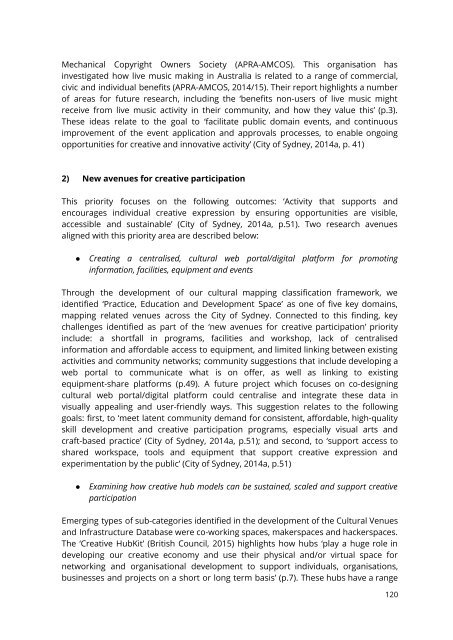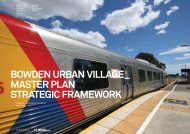MAPPING CULTURE
Mapping-Culture-Venues-and-Infrastructure-in-the-City-of-Sydney
Mapping-Culture-Venues-and-Infrastructure-in-the-City-of-Sydney
Create successful ePaper yourself
Turn your PDF publications into a flip-book with our unique Google optimized e-Paper software.
Mechanical Copyright Owners Society (APRA-AMCOS). This organisation has<br />
investigated how live music making in Australia is related to a range of commercial,<br />
civic and individual benefits (APRA-AMCOS, 2014/15). Their report highlights a number<br />
of areas for future research, including the ‘benefits non-users of live music might<br />
receive from live music activity in their community, and how they value this’ (p.3).<br />
These ideas relate to the goal to ‘facilitate public domain events, and continuous<br />
improvement of the event application and approvals processes, to enable ongoing<br />
opportunities for creative and innovative activity’ (City of Sydney, 2014a, p. 41)<br />
2) New avenues for creative participation<br />
This priority focuses on the following outcomes: ‘Activity that supports and<br />
encourages individual creative expression by ensuring opportunities are visible,<br />
accessible and sustainable’ (City of Sydney, 2014a, p.51). Two research avenues<br />
aligned with this priority area are described below:<br />
● Creating a centralised, cultural web portal/digital platform for promoting<br />
information, facilities, equipment and events<br />
Through the development of our cultural mapping classification framework, we<br />
identified ‘Practice, Education and Development Space’ as one of five key domains,<br />
mapping related venues across the City of Sydney. Connected to this finding, key<br />
challenges identified as part of the ‘new avenues for creative participation’ priority<br />
include: a shortfall in programs, facilities and workshop, lack of centralised<br />
information and affordable access to equipment, and limited linking between existing<br />
activities and community networks; community suggestions that include developing a<br />
web portal to communicate what is on offer, as well as linking to existing<br />
equipment-share platforms (p.49). A future project which focuses on co-designing<br />
cultural web portal/digital platform could centralise and integrate these data in<br />
visually appealing and user-friendly ways. This suggestion relates to the following<br />
goals: first, to ‘meet latent community demand for consistent, affordable, high-quality<br />
skill development and creative participation programs, especially visual arts and<br />
craft-based practice’ (City of Sydney, 2014a, p.51); and second, to ‘support access to<br />
shared workspace, tools and equipment that support creative expression and<br />
experimentation by the public’ (City of Sydney, 2014a, p.51)<br />
●<br />
Examining how creative hub models can be sustained, scaled and support creative<br />
participation<br />
Emerging types of sub-categories identified in the development of the Cultural Venues<br />
and Infrastructure Database were co-working spaces, makerspaces and hackerspaces.<br />
The ‘Creative HubKit’ (British Council, 2015) highlights how hubs ‘play a huge role in<br />
developing our creative economy and use their physical and/or virtual space for<br />
networking and organisational development to support individuals, organisations,<br />
businesses and projects on a short or long term basis’ (p.7). These hubs have a range<br />
120



